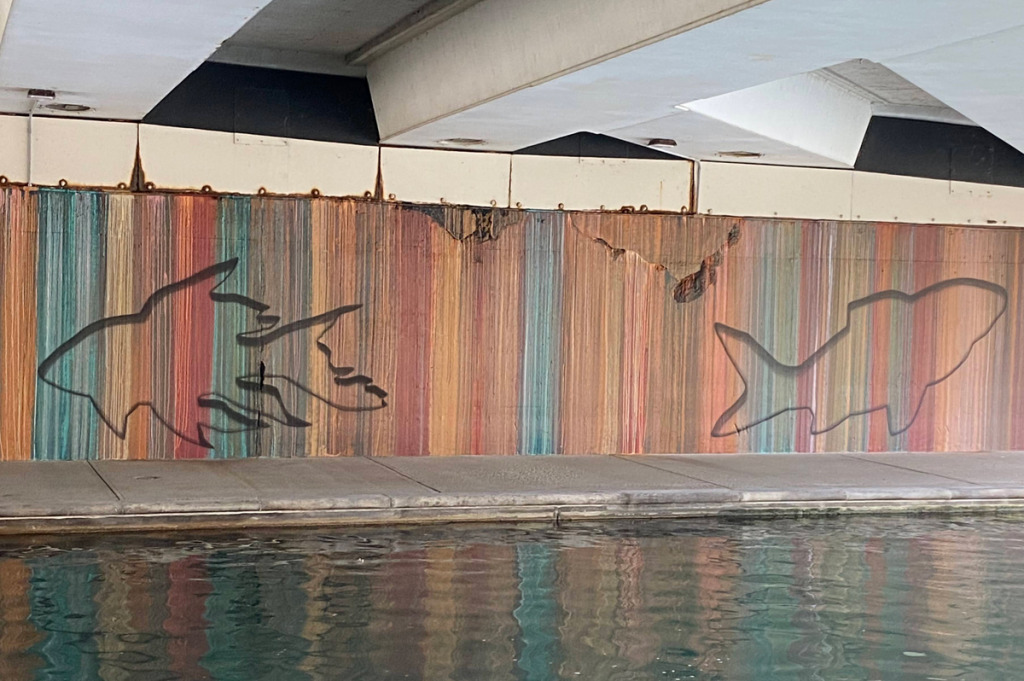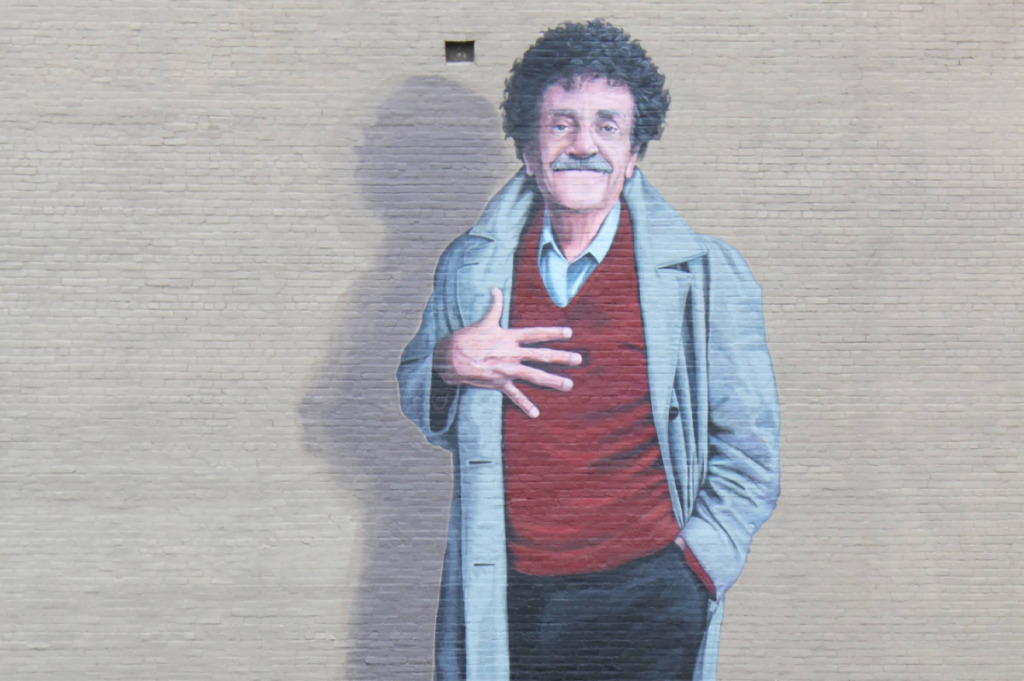Subscriber Benefit
As a subscriber you can listen to articles at work, in the car, or while you work out. Subscribe NowIt might seem unlikely now, but Mass Ave wasn’t intended to be the home of a Kurt Vonnegut mural that’s become closely identified with the cultural district.
Much larger than life at 38 feet tall, the Vonnegut painting—a defining example of public art in Indianapolis—was supposed to be in a different spot, one of dozens of murals planned for around the city before Lucas Oil Stadium hosted Super Bowl XLVI on Feb. 5, 2012.
But a historic designation meant the Vonnegut painting had to move from its planned spot on Senate Avenue to a Mass Ave building that’s now the home of restaurant Slapfish. And that prominent location has helped make it one of the most popular pieces that resulted from the collaboration between the city and Indy Arts Council (formerly known as the Arts Council of Indianapolis) titled “46 for XLVI.”
The murals were scheduled to be on display for only 10 years—and their future is now in question.
Several of the artworks already are gone because of damage, deterioration and property changes. Others, like the Vonnegut mural, have become iconic.
Now, on the project’s 10th anniversary, the Indy Arts Council is talking with artists, building owners and the public to determine what’s next for the murals. After collecting opinions, the organization will prioritize paintings and seek funding and partnerships for extending specific displays.
It’s safe to assume the Vonnegut mural won’t disappear from the side of the Massala Building at 345 Massachusetts Ave. Julia Muney Moore, Indy Arts Council’s director of public art, said the mural is consistently popular on Instagram and other social media platforms.
“The Vonnegut portrait mural is one of the ones that has really become iconic and totally rang everybody’s chimes,” Moore said.
Painting the town
Artist Pamela Bliss painted two murals as part of 46 for XLVI. Bliss paid tribute to Vonnegut, the famed author and Shortridge High School alum, and also painted jazz musicians who made Indiana Avenue a vibrant music scene in the 1940s and ’50s.
The “Indiana Avenue Jazz Masters” mural is on the side of Musicians’ Repair & Sales, 322 N. Capitol Ave, a building within shouting distance of Indiana Avenue.
The original planned location for her mural titled “My Affair with Kurt Vonnegut” was the side of The Martens, an apartment building on Senate Avenue across the street from where the Kurt Vonnegut Museum and Library could be found in 2012.
No painting could be done on The Martens, however, because the building has been listed on the National Register of Historic Places since 1983. The Vonnegut Museum and Library exited its Senate Avenue address in 2019 and now welcomes visitors at 543 Indiana Ave.
“We had to scramble to find another wall,” she said. Once the Massala was identified, project organizers asked Bliss what she planned to paint. She returned to the plan for the original location.
“I said, ‘Why don’t I just paint Kurt Vonnegut?’ I didn’t have much turnaround time,” she said.
In terms of geography, the mural has a relevant connection to the Athenaeum a few blocks northeast of the Massala. Vonnegut’s architect grandfather, Bernard Vonnegut, designed the Athenaeum, originally known as Das Deutsche Haus, with Arthur Bohn in the 1890s.
And, as Moore noted, the mural is a hit.
“It reminds people, ‘Oh, yeah, here is an icon of mid-20th-century literature who is from here,’” Moore said.
On Capitol Avenue, the “Jazz Masters” mural is a reminder of contributions that guitarist Wes Montgomery, trumpet player Freddie Hubbard and other musicians made to the world of music.
Since 2012, Bliss has added large murals of basketball star Reggie Miller and human rights activist Eva Kor to downtown buildings.
Bliss said the 46 for XLVI program elevated the reputation of murals and public art in Indianapolis. Earlier in her career, she said, people often associated murals with unauthorized graffiti tags.
“When I started back in the late-’90s, it was like pulling teeth to get people to let me put up a mural,” she said.
Artist Carl Leck, who was responsible for six of the original 46 murals, said the 2012 project brought positive attention to artists and the places where they painted.
“After the whole Super Bowl murals program happened, I saw a huge uptick in public art,” he said. “I think a lot of people and businesses saw the value in it.”
Change is constant
Leck’s experience with 46 for XLVI underscores the temporary aspect of murals. Along downtown’s Canal Walk, where 10 of the project’s artworks were installed, Leck painted a fish-themed mural titled “White River Aquaculture Preservation Aquarium.”
But drainage problems at street level of a Michigan Street bridge left the mural “beat up and worn out,” Leck said. Chunks of concrete fell from the wall, and rusty water streaked down the painting.
In 2020, he replaced the “Aquarium” piece with a new mural titled “Aqueous.” The new painting depicts the outlines of two fish against vertical lines in shades of blue, red, orange and brown.
“It’s kind of streaky in general,” he said. “I kind of played with that and used it to my advantage. I know that it’s going to end up being streaky and have some rust stains. But it won’t be as distracting.”
Leck’s other 46 for XLVI project was “Trivergence,” a sprawling mural along 10th Street near the Monon Trail, Indianapolis Cultural Trail and Pogue’s Run Trail. The painting counted as five of the 46 murals, and more than 1,000 Lilly “Day of Service” volunteers filled in Leck’s paint-by-numbers concept.
If you didn’t see “Trivergence” in person, you won’t have another chance. The painting is being dismantled as part of the North Split reconstruction project at the I-65/I-70 interchange.
“It had a good run,” Leck said. “I think other people have their feelings hurt about it coming down more than me. It doesn’t bother me as much, because the only constant is change. It had a good run, and it looked good for a while.”
In search of keepers
Before the demise of “Trivergence,” seven of the 46 for XLVI murals were designated as “deinstalled”:
◗ “The Death of Ambition,” by Artur Silva, was an inkjet-on-vinyl artwork that faded above South Illinois Street at the CSX railroad overpass.
◗ “Mud and Twigs”/”Branch Weaver”/”Stilled Stream,” by late Indianapolis artist Wug Laku, was designed for a two-year display outside the Indy Arts Council offices.
◗ “Furry Animal Buddies,” by graffiti duo Fab Crew, was damaged and then replaced by a different mural at IndyHumane’s downtown location.
◗ “Jacks,” by Will Schlough, was displayed on a Meridian Street building that’s been razed.
◗ “Served,” by Andy Miller, and “Unite for Culture and Community,” by Clayton Hamilton, were taken down after a new tenant moved into the former Big Car Service Center near Lafayette Square Mall.
◗ “On the Map,” by Eduardo Mendieta, was displayed on a Speedway building that’s been razed.
Moving forward, Indy Arts Council wants to identify which 46 for XLVI murals will be preserved. Moore mentioned scenarios in which the Indy Arts Council would maintain murals, property owners would purchase murals, or the Indy Arts Council and property owners would share the cost of mural maintenance.
The public can vote for their favorite 46 for XLVI murals as part of an online survey at indyarts.org/murals.
The original project was funded at $500,000, a mix of public and private investment with $200,000 spent by the city and $150,000 spent by the Capital Improvement Board.
“I think it showed people what essentially an artist’s fee and a little bit of paint could do to really change someone’s perception of a place,” Moore said.
Although several of the 46 for XLVI murals no longer exist, Bliss said the artform makes a lasting impression.
“I call them ‘semi-permanent,’” Bliss said. “After I’m gone, these murals could be refurbished over and over. A mural can be temporary, but the important thing is that it sometimes introduces art to people who don’t typically get that exposure. Even if it’s temporary, it’s really important.”•
Please enable JavaScript to view this content.






The article states that “no painting (specifically the Vonnegut mural) could be done on The Martens, however, because the building has been listed on the National Register of Historic Places since 1983.” Just to be clear, there is no such restriction imposed by the National Register, the primary purpose of which is to “identify historically significant buildings, districts, structures, sites, and objects and document their significance.”
In fact, being listed on the National Register alone does not place restrictions on the property owner, nor does it necessarily preserve a property in the future. Contrary to popular belief, listing a property on the National Register will not stop any private, local or federally funded projects or require review for any privately funded projects with no federal or state involvement. Listing does not require the owner to provide public access to the property. Listing will not restrict the rights of private property owners in the use, development, or sale of their property, nor will it lead automatically to the creation of a regulated historic district.
The Indy Arts Council and artists need to understand this as it endeavors to add more murals to our cityscape in the future.